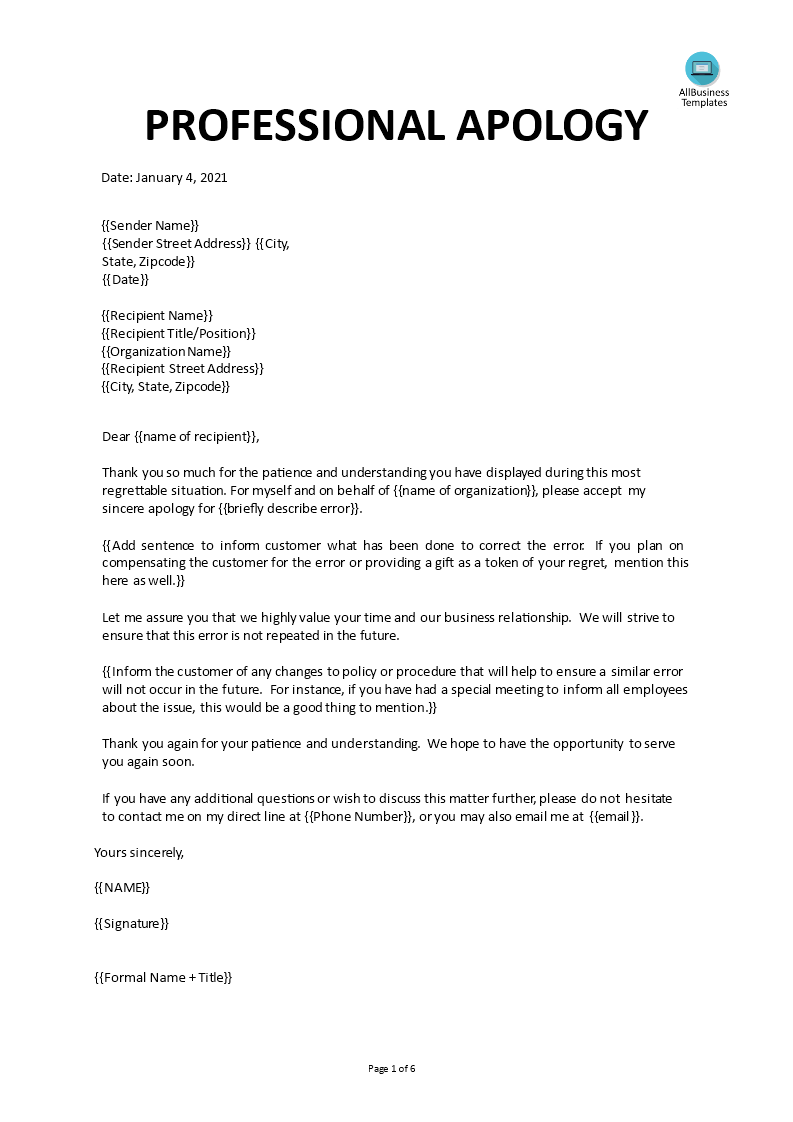Business Formal Apology Letter
Sponsored Link免费模板 保存,填空,打印,三步搞定!

Download Business Formal Apology Letter
微软的词 (.docx)免费文件转换
- 本文档已通过专业认证
- 100%可定制
- 这是一个数字下载 (45.88 kB)
- 语: English
Sponsored Link
How to draft a Business Apology Letter? An easy way to start completing your letter is to download this formal Apology message template now!
The way you deal with mistakes is the most important part of the actual problem that was caused and how people will perceive you and the company you represent. You can for example accept the mistakes, provide solutions, remember how the situation is caused, be kind and polite. The other side is that you start to defend and let it go. However, that may not be the best outcome for the future.
Don't reinvent the wheel every time a situation occurs that is not already experienced by others close to you. For example, when you write an apology letter to a client, make sure to start by saying sorry and express sincere regret. You need more than one sentence to do that! Then also be specific about what happened, what problems occurred. Express yourself in ways that the client can validate and relate to the feelings: think also about the 'client of the client', is he/she harmed in any way? Of course, it's very important to show what steps you or your company will take to make sure the inconvenience won't happen again.
Why is writing an business apology so hard?
Apologizing is not easy at all. We can say that it is a form of art. We need to master it. Sometimes, it happens that we do not want to accept our mistakes because we think that it will make a negative impact on our character. But in reality, there is no such thing. Apologizing is not bad at all instead it makes a good impression of you in front of your recipient and it makes you humble. So, there must be a proper and professional way to write an apology letter. in the coming context, we will guide how about how you can write an effective apology letter.
What a good business apology letter consists of?
To make a good impression of yours in front of your recipient, there are few tips that you need to remember to master in writing a perfect apology letter. Below mentioned guidelines are applicable to either a personal/individual apology letter and a group apology like from companies and brands in case of some customer’s issue.
Mention that you are sorry:
- In the first paragraph of the apology letter, you need to mention that you are sorry for whatever loss you made to the recipient.
- Accept your mistake: by accepting your mistakes, it makes a good impression on the recipient how you are ready to compensate and step forward to make up the loss you made to them.
- Explain the Situation: If you think that there was a natural/unintentional issue that made a loss to the recipient, then you must explain the whole scenario to the person. It also is necessary because if you want the other person to accept your apology, you must describe what went on and what made this disaster happen.
- Provide Compensation: The best part of an apology letter is where you provide the necessary compensation to the recipient. This part will make the wrong person accept your apology really quickly.
- Ask for Forgiveness: Asking for forgiveness will really show the recipient that you are humble and accept all the errors.
- Ending with hope: In the end, you should write about the hopes you have from the recipient about the incident that happen. Provide acknowledgment and stay humble.
Instead, we provide this standardized Business Formal Apology Letter template with text and formatting as a starting point to help professionalize the way you are working. Our private, business and legal document templates are regularly screened by professionals. It comes in Microsoft Office format, is ready to be tailored to your personal needs. Completing your document has never been easier!
Using this apology guarantees you will save time and provide sufficient inspiration. Sending out a proper apology is important. Download this sample apology letter template now for your own benefit, and enables you to reach the next level of success and grow the business!
Download this Business Formal Apology Letter template now for your own benefit!
DISCLAIMER
Nothing on this site shall be considered legal advice and no attorney-client relationship is established.
发表评论。 如果您有任何问题或意见,请随时在下面发布
相关文件
Sponsored Link

